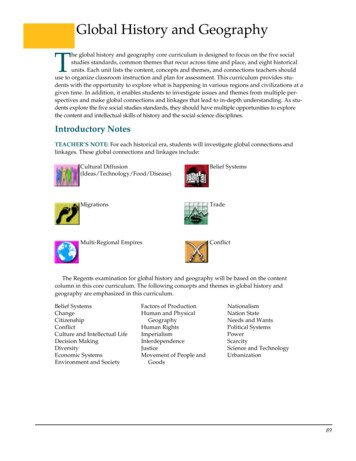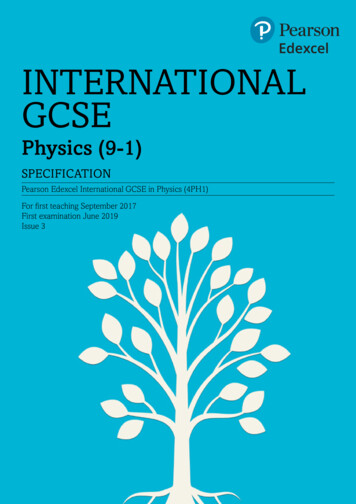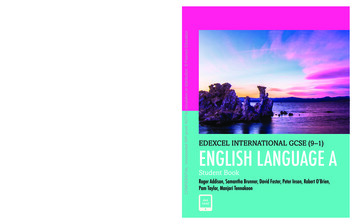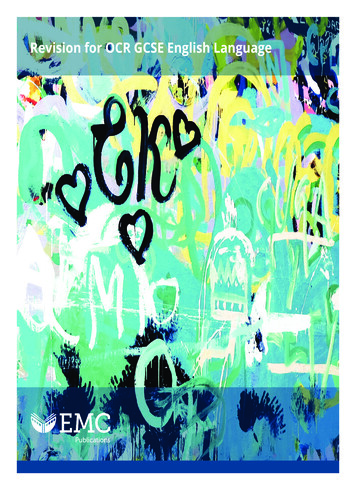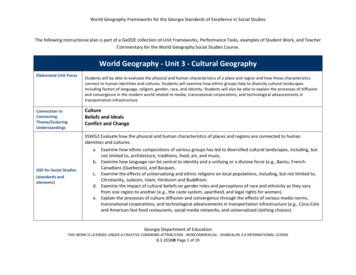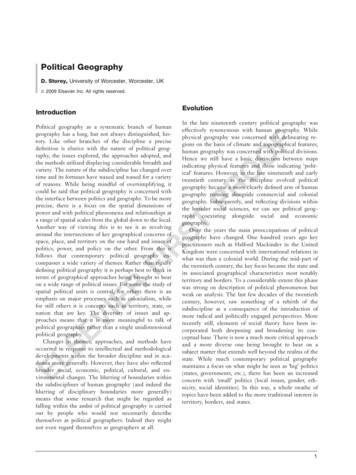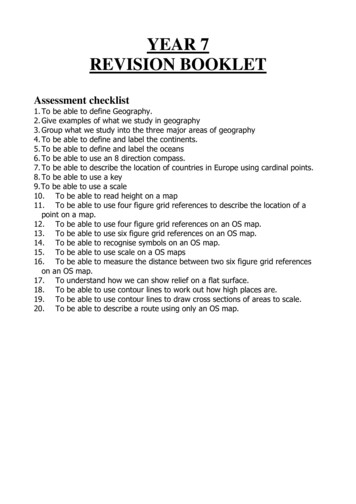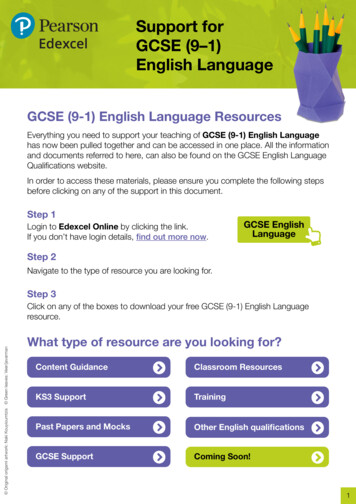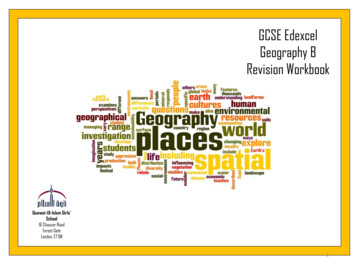
Transcription
GCSE EdexcelGeography BRevision WorkbookQuwwat-Ul-Islam Girls'School16 Chaucer RoadForest GateLondon, E7 9N1
Table of Contents1. Breakdown of Assessment Objectives 32. Command words .43. Mathematical skills 54. Geographical skills 65. Tips on how to revise for Geography .76. Useful websites 87. Keyword definitions .98. Case studies summaries .109. Topic summary notes . .11-1910.Topics 1-5 worksheets . .12-3111.Exam practice questions .32-352
Breakdown of AssessmentObjectives and Exam PapersThis is a breakdown to helpyou understand your GCSEGeography better.Here you will identify totalmarks, percentages and timefor each exam paper.3
Understanding‘command words’Most people miss out onmarks because they did notunderstand what the questionwas asking them to do.Make sure you know whatyour command words mean.These are the words that tellyou what to do.4
What skills will I be assessed on?Mathematics and Statistics SkillsFamiliarise yourself with each skill.Identify your strengths and weaknessesand focus on improving those with exampractice.These skills are taken from the document Geography GCSE subject content published by the Department for Education (DfE) April2014. These skills may be assessed across any of the examined components. Some mathematics and statistics skills are specific toparticular subject content; these are indicated in the ‘integrated skills’ sections within the topics throughout the specification.Cartographic skills: use and understand gradient, contour and spot height on OS maps and other isoline maps interpret cross sections and transects use and understand coordinates, scale and distance describe and interpret geo-spatial data presented in a GIS frameworkGraphical skills: select and construct appropriate graphs and charts to present data, using appropriate scales and including bar charts, pie charts,pictograms, line charts, histograms with equal class intervals interpret and extract information from different types of graphs and charts including any of the above and others relevant to thetopic interpret population pyramids, choropleth maps and flow-line mapsNumerical skills: demonstrate an understanding of number, area and scale and the quantitative relationships between units design fieldwork data collection sheets and collect data with an understanding of accuracy, sample size and procedures, controlgroups and reliability understand and correctly use proportion and ratio, magnitude and frequency draw informed conclusions from numerical dataStatistical skills: use appropriate measures of central tendency, spread and cumulative frequency (median, mean, range, quartiles and inter-quartilerange, mode and modal class) calculate percentage increase or decrease and understand the use of percentiles describe relationships in bivariate data: sketch trend lines through scatter plots; draw estimated lines of best fit; make predictions;interpolate and extrapolate trends be able to identify weaknesses in selective statistical presentation of data5
What skills will I be assessed on?Geographical skillsFamiliarise yourself with each skill.Identify your strengths and weaknessesand focus on improving those with exampractice.Students are required to develop a range of geographical skills throughout their course of study. These skills maybe assessed across any of the examined components. The full list of geographical skills is given below. Somegeographical skills are specific to particular subject content; these are indicated in the ‘integrated skills’ sectionswithin the topics throughout the specification.Atlas and map skills: recognise and describe distributions and patterns of both human and physical features at a range of scales usinga variety of maps and atlases draw, label, annotate, understand and interpret sketch maps recognise and describe patterns of vegetation, land use and communications infrastructure, as well as otherpatterns of human and physical landscapes describe and identify the site, situation and shape of settlementsGraphical skills: label and annotate and interpret different diagrams, maps, graphs, sketches and photographs use and interpret aerial, oblique, ground and satellite photographs from a range of different landscapes use maps in association with photographs and sketches and understand links to directionsData and information research skills: use online census sources to obtain population and local geo-demographic informationInvestigative skills: identify questions or issues for investigation, develop a hypothesis and/or key questions consider appropriate sampling procedures (systematic vs random vs stratified) and sample size consider health and safety and undertake risk assessment select data collection methods and equipment to ensure accuracy and reliability, develop recording sheets formeasurements and observation use of ICT to manage, collate, process and present information, use of hand-drawn graphical skills to presentinformation in a suitable way write descriptively, analytically and critically about findings develop extended written arguments, drawing well evidenced and informed conclusions about geographicalquestions and issues.6
Geography GCSE 9-1 Edexcel B Investigating Geographical IssuesHow to revise Geography2. Make sure you understand1. Get organisedMake sure you knowwhat topics you arebeing tested on inwhich paper.Use your ‘topicchecklists’ toorganise yourthoughts and revisionmaterial3. Revision cardsCondense your notes andinformation onto revision cards.Use differentcoloured cards torepresent each topic or adifferent case study.The first step in remembering anything is understanding it. Thesetips will help you with this: Make sure you’ve seen a map of the place. In this day andage this is easy with google maps, google earth and googlestreetview. All of these things can help you understand boththe 2-D and 3-D landscape of the case study. Find newspaper articles and pictures to give you somebackground and also help you to visual the place Watch videos if they exist. For some case studies there areamazing clips of films (Kibera, the Nairobi shanty town at thebeginning of The Constant Gardner springs to mind). Forothers there will be great video clips on YouTube to help you. If you can, visit the place. Nothing is as powerful as this infully understanding a place.5. Use Seneca ClassroomUse our Seneca Classroom to retrieverevision notes for more information.Retrieve your class code from your tutor.7. Memorise!Now you’ve condensed your class notes youneed to memorise them. Goodmemorisation, in my experience comesdown to two things: Repetition Using the information in differentformats.I’d advise you to do a combination of thefollowing: Read index cards out loud, cover andtest yourself. Get other people to test you. Act it out. Make up songs or rhymes Whatever else works for you 4. Mind mapsOrganise yourcase studies ortopic notesonto mindmaps. Aim forone topic perA3 page6. Revision booksPurchase a revision book,specifically the ‘Revise EdexcelGCSE (9-1) Geography B RevisionGuide’ published by Pearsonaround 6. ISBN 97812921337828. Exam command wordsUnderstand the command words used in exams. What isthe difference between a ‘describe’ and ‘explain’ question?9. Past papersMake sure you’re exam ready by practising to apply yourknowledge to past questions10. Analysing mark schemesAnalysing the mark schemes to understand what theexaminers are expecting you to do.7
Useful websites and linksEdexcel GCSE Geography BUse this websites to help you with keywords, case studies and earsonschools.co.uk/reviseYouTube Channels: 9-1 GCSE Geography / Geographer Online8
For more Topical Keywords go to:https://www.gcsegeography.co.uk/keywords9
For more case study examples go to:https://www.gcsegeography.co.uk/case-studies10
On the next few pages you will find topic summaries.Use these pages to help support you complete your revisionworksheets.Case Study:DevelopmentIndiaDynamicsWhere is India located?Continent: AsiaNearby countries: Pakistan, SriLanka, Bangladesh, NepalNearby oceans: Indian Ocean,Arabian Sea, Bay of BengalIndia has undergone rapiddevelopment in recentdecades which hasresulted in India nowbeing identified as anemerging country, ratherthan a developingcountry.The general trend inemployment has been aloss of primaryemployment, with anexpansion of the servicessector.India is the 7th largest country inthe world by land mass.Think like a geographer: How does India’s locationpromote economic development? What other major economies are nearby? China!Now a major economy and superpower. India andChina have existing political tensions. India is aformer British colony. Is India landlocked? Which countries are easilyaccessed? India is not landlocked, meaning it caneasily transport goods internationally by boat. Indiaaims to become a major transport hub within southeast Asia. Is India a large or small country? What about itspopulation? India is a large country, with goodaccess to resources such as coal. India’s populationis rapidly growing, totals 1.324 billion (2016). Thismakes India the second most populous country inthe world.DevelopmentIndicatorSocial, Economicor EnvironmentalValueSocial, Economicand Environmental0.621 (131stin theworld)Life ExpectancySocial68 yearsAdult LiteracySocial74%Social34 per 1000birthEconomic 1,709HDI (HumanDevelopmentIndex)Infant MortalityGDP (Grossdomestic Productper capita)GeopoliticsIndia’s Economic DevelopmentDevelopment DynamicsIndia’s imports andexports have grown, asIndia buys and sells moreproducts internationally.India’s total importshave grown by almost1500% since 1980.Impact of DevelopmentDefinition: How are a countries world politics influenced bygeographical factors.Economic Development on Different Age and GenderGroupsWhat controls India’s geopolitics?: It’s history, geography,international context and domestic policiesThe Elderly (50 ): Access to better healthcare, which mayprolong their life. Do not possess necessary skills so maylag behind. Socially, changes to the Indian society may bedifficult to adapt to.Globally: India is a member of theG20. The G20 are the twenty mostdeveloped economies in theworld. These countries meet everyyear, and discuss world tradeissues.WeaknessesA large transnationalcorporation (TNC), withheadquarters in the UK.Who/What does India trade with?Aviva have call centres inPerth (Australia), Norwich(UK) and Sheffield (UK).Export:Goodssold toothercountriesImport:Goodsboughtfrom othercountriesThe typesofproductsIndiamakes andsellsEnvironment: The atmosphere (pollution), the green space,wildlife, rivers and water systems etc. Why India?Wages much lower (India 1,200, UK 12,000)The cost of operation is lower by up to 60%.Improvements in education levels.Fewer safety restrictions longer hoursAdvantages of AvivaDisadvantages of AvivaBring much needed moneyto the Indian economy,creating 1000s of jobs .A fifth of all call centre jobsoutsourced, weakening theUK economy.Increase developmentlevels, investing ininfrastructure.Retain profits, and pay tax inthe UK. This limits theeconomic benefit toBangalore.OpportunitiesIndia is ranked as the 155th country out of 177 in a globalranking on environmental quality. This costs India around 80 billion per year (5.7% of its total economy)The effectsAviva is the UKs largestinsurance companyBangalore, India.Rate ofchange infemaleliteracy rates(11.8%)greater thanmales (6.8%)between2001-2011.Impact on the environmentThe rise of the call centreIndia’s development has been unequal. and has led tocontrasting development levels. Compare the darkregions (higher GDP) to the lighter colours (lower GDP).StrengthsFemales: The BIGGEST winners: Emancipation of women equal access to a high quality education and healthcaresystem, which enables them access to highly skilled jobsthat are well paid.Young adults:Access topuniversities,receiving aworld classeducation compete forthe highestskilled andpaid jobs more equalsociety.In Asia: The partitioning ofIndia and Pakistan in 1947was accompanied withriots and mass casualties.The effects of this are stillfelt today:The relationship betweenIndia and Pakistan is still farfrom healthyBoth countries are nucleararmed.SWOT Analysis Solid Waste Pollution:Indian cities generate100 million tonnes ofwaste each year.40% of urban waste inIndia is just simply notcollected, and isallowed to rot on thestreets. Water Pollution:India has thecapacity the dealwith just 1/6 of itssanitationproduced.Over 100 Indiancities directlydump untreatedsewage into theGanges.Air Pollution:Major issue in India, with wood burning and vehicleemissions behind the primary cause.Natural methods of fuel production (wood burning)constitutes 90% of rural energy, and 24% of urbanenergy. These biomass house burners are theleading cause of greenhouse gas emissions.Threats
Challenges of an Urbanising WorldRapid Population GrowthCase Study: MumbaiMumbai is located in theMumbai has a totalregion of Maharashtrapopulation of 18 millionpeople! Compare this toBirmingham, which haspopulation of just 1 million!Contrasting Qualities of Life (QOL)Bottom Up DevelopmentMumbai is a globally important megacity, but falls short in termsof quality of life. Mumbai has a poor level of infrastructure whencompared with megacities in other emerging Asian economies.SPARC Community ToiletsWhy is QOL so low in Mumbai?Notice how well connectedMumbai is to other areas inIndia. This allows for the easyflow of resources and peopleinto, and out of Mumbai.Think like a geographer: How does Mumbai’s location andconnectivity promote economic development? Access to the ocean: Natural deep harbour, easily accessiblefor modern container ships, promoting exports and imports. Mumbai’s location in India: Western coastline of India. Quickaccess via boat or plane to the major emerging economies ofthe middle east. So how important is Mumbai’s location? 25% of allinternational trade within India is handled by the dock inMumbai.The suburban railways of Mumbai arevital to the connectivity of the city.The roads are often gridlocked. In asingle day, the suburban trainnetwork carries around 7.5 millionpeople.The structure of MumbaiDoes it fit with the Burgess Model?OuterSuburbsCBD: Tip ofMumbai, majorhistoric centre.Bank of Indiaand WaltDisney locatedhere. Largeport shippinginternationally.Inner Suburbs:First areadeveloped tohouse workers.Large percentagein poverty and inslum housing.This does notmatch Burgessmodel.Inner City: Major contrasts indevelopment levels. Some veryexpensive, some old slumhousing (25,000 people)Convinces a person to moveaway from their rural homeFactorEffectInefficient Government(political, economic)The government is ineffective.Housing projects take a long timeto develop, with a lack ofsanitation systems being a majorhold up.Rent Controlled(economic)Attracts a person to MumbaiCorruption(economic, social)Limits put on how much rent cancost. This discourages theproperty owner from investing inthe property as they cannotmake as much profit.Housing that is redeveloped isoften sold to developers thatbuild expensive properties, farout of reach of most localMumbai residents.Top Down DevelopmentThe Challenges of Living in MumbaiTraffic Congestion:Rapid rise to 1.8 million privatelyowned cars in Mumbai as people gainwealth and cars become affordable.Slum settlements:Slums inner city/suburbs, makingtravel to work cheap. Slums are notofficially recognised. In Dharavi, wateris only available from a standpipe for a2 hour period each day.Working Conditions:Most work in the ‘informal’ sector(unregulated), which means low pay,long working hours and dangerousworking conditions. These conditionsexist due to extreme poverty, and theneed for any work to earn a wage.Rapid Expansion: Major strain oninfrastructure and services. Ensuring areliable electric supply and adequatewater supplies is difficult. No wastecollection 800 million tonnes ofuntreated sewage dumped Mithi River.The Mumbai MonorailDefinition Large, expensiveinfrastructure projects oftenfunded by governments or FDI. Definition: The opposite of topdown. No governmentinvolvement, these are strategiesdesigned by local communities toimprove the QOL. Theseorganisations are often NGOs. Why Toilets?Improved sanitation. Disease and poor health are often a resultof poor sanitation and raw sewage.Access to clean water for washing purposes – again improvinghealthcare and lowering the risk of disease.Access to clean toilets that are connected to the cities sewage networkSPARC toilet blocks offer:Electrical lighting makingthem safe for night timeuse. Separate toilets forchildren to use, ensureprivacy and safety A bottom up development encourages the local community tobecome involved in the project. You could argue though that this is ajob that the Mumbai government should be addressing, and NOT localNGOs!SWOT Analysis of MumbaiStrengthsOpportunitiesWeaknessesTargetsWhy a monorail?Monorails are a form of public transport, reducing thecongestion of cars.Green transport – Reduction in total emissions due to fewercars generating atmospheric pollutants.In 2005, the Mumbai government agreed to invest 310 millionpound in a 9km stretch of Monorail.Tickets are cheap (10p per person), but the route DOES NOT travelthrough the main area of the city. As a result, only 15,000 journeysare made each day, most of these being tourists!!!Conclusion: The monorail is arguably anattention grabbing prestige project,designed to impress other countries byshowing how developed and futuristicMumbai is. This is FAR from the truth!Are they the solution to Mumbai’sdevelopment crisis?
Battle of the BiosphereDistribution of biomesThe biosphere has a life support systemKeywords:Degradation: the social and economic and environmental decline ofan area.Conservation: managing the environment in order to preserve it orrestore itHow have humans affected the biosphere ?Case study: Amazon RainforestFactors affecting biomesThe biosphere is influenced by the atmosphere (air), hydrosphere (water cycle)Changes for the UKand lithosphere (rocks and soils). Other local factors that influence biomesIftemperaturesincrease by 2-4 Cinclude –Global factors: precipitation, temperature , latitude, distance inlandLocal factors: altitude , geology , soils, human interference1.Changed growing season2. New marine life3. Moving tree lineMining: The Grande Carajas development bought iron mines, roads built totransport resourcesTimber: Commercial clearance of tropical hardwoodAgricultural land: landless farmers migrate to Amazonia and cut down forestfor firewood and to grow cropsSoya craze: clear land to grow soya beans to sell or to feedcattlePeople pressure: Brazil increasing population growth , more land is needed forfarming and housing 20 million havemigrated towards the AmazonDeforestation: more CO2 in the atmosphereBiosphere conservation/managementRamsar Convention on Wetlands: 2060 wetlands have special protectionCITES: penalties for poaching endangered animalsNational Parks: protects 13% of the land , globally overseen by the UNChallenges to sustainability Population increase Rising resource consumption Climate change : increase in evaporation and precipitation rates Conflicts with different stakeholders of biomes e.g. Local people, government , businessesSustainable managementSustainable management as worked well in the Caledonian Forest, ScotlandThe Caledonian Forest is an important biological resource. The forest is an important environmental inheritance for people living inthe Scottish Highlands. The European Union has provided funding for the restoration of this internationally important habitat for thebenefits of future generations. One of the objectives is to bring back lost animal habitats and populations within a part of the forestknown as Glen Affric.The aim is to restore biodiversity to its natural level by adopting a countryside management strategy known as environmentalstewardship. One of the first decisions taken was to reintroduce wild boar to Glen Affric, a species that has been hunted toextinction over the years. Wild boards feed on all sorts of forest floor organisms (such as fungi and insects). They disturb forest floorvegetation in ways that can aid the growth of trees. Forest managers describe the boards as a very useful ground disturbance force.There are similar ideas to reintroduce other lost animals in some Scottish forests, including wolves, lynx and brown bears. These areall regarded as dangerous animals by the public, which makes the idea highly controversial.13
UK Urban change in the last 50 years1. EconomicDeindustrialisation: closure of largemanufacturing industries e.g. LondonDocklandsGrowth of tertiary and quaternaryindustries :London Docklands 1980sWealth gap: widened leaving pockets of areasdeprived many inner city and rural areas.2. PoliticalNational government polices1980s Urban development Corporations ,Enterprize zones e.g London DocklandsChanging Settlements in the UKChanges in urban areasThe impacts of the housing demand3. SocialGrowth of leisure and recreational facilitiesHigher incomes and better transport-move tobuild housing, work , leisure facilities on ruralurban fringeCounter urbanisation : people moving to ruralareas4.Demographic (population)Population growth has meant morehousing, services and businesses neededInternal migration– people moving from placeswith fewer jobs e.g. Remotehighland areas to where there are more jobopportunitiesImpact of housing demand in an urban areaCase study: LeedsThe Index of Multiple deprivationconsiders Housing Jobs Education Income Services e.g shopsIndex of Multiple deprivationCase studiesCanning Town Vs Richmond Upon ThamesExam Question: Using named examples, describe how residential areas of a cityvary (6)Explain why some areas have experienced areas of multiple deprivation (6)Commuter VillagesWhere: Outside the URBAN FRINGE close to towns and citiesPopulation: people moved from URBAN areas , YOUNG familiesBenefits: improved TRANSPORT links make it easier to travel jobs in theCITY/TOWNDisadvantages : decline in services because people use services near workRetirement communitiesWhere: mainly COASTAL areasPopulation: large % of older people due to older people migrating in andyounger people leavingWhy: longer life expectancy want to live in quiet attractive placesBenefits: cheaper housing , specialised services as towns have adapted to theaging populationContrasting rural areas : QUALITY of LIFEScottish HighlandsUnemployment is low butavailable jobs are mainly in theprimary sectorThe remoteness and relief of theland means that there are fewindustries and businessesEconomy relies on agricultureand tourismDeclining and aging populationAccess to beautiful countrysideEast AngliaMany jobs are seasonal e.g. FruitpickingLife expectancy is higher than nationalaveragePleasant climateMost residents can commute toLondon and CambridgeMany coastal areas are in decline(WOTN)Varied employment14
The Clark Fisher ModelGlobalisationNote the time scale at the bottomLICs/LEDCs: Mainly work in the Primary sectorAs a country gets wealthier .HICs/MEDCs: Mainly work in the tertiary andquaternary sectorReasons for globalisation1. Transport: container ships and airtravel2. Communication: email, text, fax,phone3. IMF (International Monetary Fund)state led investment to helpcountries4. TNCs: increased trade betweencountries5. Trade agreements: agreementsbetween countries e.g.EU have madetrade easierWhy TNCs operate globallyTNCs : Transnational Corporations1.Cheap labour2.Cheap buildings and land3.To be close to markets4.countries offer incentivesCase study: NikeHeadquarters: Oregon USAOffices in 45 countries 700 shopsworldwideHas been accused of exploitingpeople in sweatshops.What you need to know !!!!!!!!!!!!! Employment structure Reasons why there is a Changing employmentstructure over time (Clark-Fisher Model) Working conditions of employment sectors Evaluate the working conditions for men and womenin the developing and developed world Why globalisation has occurred e.g.communications and transport etc The role of global institutions e.g. IMF, UN etc The role of TNCs in the secondary and tertiary sector15
Population dynamicsKey termsBirth rate: number of lives births per 1000 per yearDeath rate: number of deaths per 1000 per yearInfant Mortality rate: number of children who diebefore the age of 1 per 1000Natural increase : Birth rate—death rateImmigrants: incomersEmigrants : outcomersLife expectancy: the age you’re expected to live toEconomically dependents: really young or oldFactors contributing to a fall in mortality Modern medicines Vaccinations Better healthcare Hygienic housing Clean water Better dietFactors contributing to fall in birth rate Access to contraception Women educated Economic burden Marrying laterHigh birth rateEconomic asset, religious reason, boys, lack ofcontraceptionFuture populations? More contraception Wars Natural disasters Diseases e.g. HIV/AIDSYouthful population Pressure on schools and housing Pressure on future employmentAgeing population Pressure on healthcare and nursing homes Pressure on taxes to pay pensions ‘grey pound’ strong spending power Look after grandchildrenMigrationBenefits for the host country Workforce Willing to work longer hours New cultures: entertainment Skilled workersNegatives for the host country Jobs givens to migrants Send money back to their country Pressure on housing and schoolsBenefits for the source country Less pressure on resources Money sent homeNegatives for the source country Loss of economic active Loss of ‘brain drain’ Family breakdownsPopulationPyramidsPopulation pyramids: LOOK AT THE SHAPEWide at bottom high birth rateWide at the top low death rateNarrow at the bottom low birth rateNarrow at the top high death rateBulging in the middle economically activeUnderpopulatedManaging populationsoptimum populationoverpopulatedPro-natalist: encourages people to have children e.g. SingaporeTax rebates, cheap nurseries, spacious apartments, government sponsoreddating websiteAnti-natalist: discourages people to have less children e.g. China’s One ChildPolicy 1979Consequences: Female infanticide, marrying age limits, forced abortions120:100 ratio, spoilt ‘little emperors’ bride kidnapping , ageing population,shortage of labour in the future.Migration policyOpen door policy Government inviting migrants e.g UK 1950Commonwealth countries given free entry Might be under populated and need to build uptheir economy Meet shortage of skilled/unskilled quotasSkills test 5 tiers Have to meet the skills criteria to enterdepending on what the country needs Full fills gap in the workforceImpactsUK workers argue their jobs being takenPressure on resourcesContribute to the economyPush factors: war, poor education, lack of services , political instabilityPull factors: better jobs, education, healthcare, better services16
Restless earthCrust A relatively thin layer of solid rocks around the outsideof the earth. Continental crust has an average depth of 5kmand is mainly composed of Granite. Oceanic crust has anaverage depth of 70 km and is mainly composed of Basalt.The average temperature of both is 10 CMantle A layer of melted rock 2900 km beneath the crust.Very hot with a temperature of 375 C and solid, but has theconsistency of treacle.Outer core A layer of molten rock 2900 – 5000 km below thecrust. Average temperatures of 3000 C and an iron / nickelcomposition.Inner core - The centre of the earth with a radius of 1400 kmand temperature of about 5700 C and an iron / nickelcomposition.Preparing for a hazard have evacuation routes Earthquake drills e.g. Japan Strengthening structures e.g. Shock absorbers, deepfoundations, reinforce framework , base isolators ,flexible gas and electricity pipesEXAM TIP: You need to say how these help lessen theimpact of an earthquakeComposite Volcano Alternating layers of ash and lava Pyroclastic flows Andesitic lava ViolentDestructive:This happens when oceanic andcontinental plates move together. The oceanic plate isdenser (heavier) than the continental one and isforced down into the mantle. Here it melts and isreleased as magma (volcano). The continental plate isforced up (Fold Mountains) and earthquakes occurdue to the movement of the plates. E.G. South EastJapanConstructive: New crust forms in undersea valleys inmid – ocean. Oceanic plates move apart causingmagma to rise up as a volcanic eruption, and oncecooled new land is formed. The new crust graduallypushes the older crust sideways, and away from theridge. A mid- ocean ridge (undersea mountain chaindevelops). Minor earthquakes occur. E.G Mid AtlanticRidge.Conservative: Two plates move past oneanother. Pressure builds up as the plates movecausing a massive earthquake. No crust iscreated or destroyed and no volcanic eruptionstake place. E.G. San Andreas Fault, California.Collision: Continental plates converge (movetogether). They are buckled and pushed upto form Fold Mountains. No eruption, butviolent earthquakes occur. E.G. Himalayas.Shield Volcano Constructive boundaries Gentle slopes Basaltic lava Eruptions rarely violentResponses to a hazard Sending aid/relief Evacuate people Set up shelters Send food and water17
Volcanic example in an LEDC (Montserrat)Earthquake example in an LEDC (Haiti)Location: Montserrat in the Caribbean.Volcanic area: Soufriere Hills.Date of eruption: July 1995Eruption lasted: 5 yearsChances Peak Volcano had been dormant for over 200 years.Emergency plans: Evacu
Purchase a revision book, specifically the ‘Revise Edexcel GCSE (9-1) Geography B Revision Guide’ published by Pearson around 6. ISBN 9781292133782 7. Memorise! Now you’ve condensed your class notes you need to memorise them. Good memorisation, in my experience comes down to two
